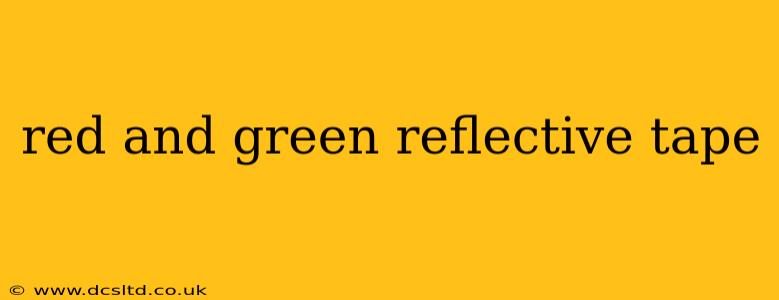Reflective tape, available in a vibrant array of colors including red and green, plays a crucial role in enhancing visibility and safety across various applications. From marking hazards on roads to improving the nighttime visibility of vehicles and equipment, its importance cannot be overstated. This comprehensive guide explores the diverse uses of red and green reflective tape, different types available, and crucial factors to consider when making your selection.
What are the different types of reflective tape?
Reflective tape is categorized based on its reflective material and application. The most common types include:
-
Microprismatic Reflective Tape: This type uses millions of tiny glass beads to reflect light back to its source, resulting in a brighter, more focused reflection. It's highly durable and weather-resistant, making it ideal for outdoor use. Microprismatic tape often provides the strongest and clearest reflection.
-
Engineering Grade Reflective Tape: Known for its exceptional durability and long lifespan, engineering-grade tape is frequently used in demanding environments and often features a strong adhesive for secure bonding.
-
Self-adhesive Reflective Tape: This is the most common type, easy to apply and suitable for a wide range of surfaces. The adhesive backing ensures a strong bond, minimizing the risk of peeling or detachment.
-
High-Intensity Reflective Tape: Providing superior reflectivity compared to standard options, high-intensity tape is essential where maximum visibility is paramount, such as on emergency vehicles or high-traffic areas.
What are the common uses of red and green reflective tape?
Red and green reflective tape, while sharing the fundamental property of reflectivity, find distinct applications due to their inherent color associations:
-
Red Reflective Tape: Often signifies warning or danger. It’s frequently used to:
- Mark fire exits and emergency equipment.
- Highlight potential hazards like low-hanging branches or uneven terrain.
- Identify fire trucks, emergency vehicles, and safety equipment.
- Indicate stop signs and other traffic control devices.
-
Green Reflective Tape: Often associated with safety and guidance. Common applications include:
- Marking pedestrian walkways and pathways.
- Highlighting safe zones or emergency assembly points.
- Identifying emergency response lanes and routes.
- Improving the visibility of signage at night.
What is the difference between red and green reflective tape?
The core difference isn't in the reflectivity itself, but in the meaning conveyed by the color. Both types utilize the same underlying reflective technology (microprismatic or other), but their color dictates their application and the message they communicate. Red signals danger or a warning, while green suggests safety or guidance.
How do I choose the right reflective tape?
Choosing the right reflective tape depends on several factors:
-
Application: Consider where the tape will be used and the level of visibility required. High-traffic areas or emergency situations demand higher intensity tape.
-
Surface: Ensure the tape's adhesive is compatible with the surface it will be applied to. Different tapes are formulated for various materials like metal, plastic, wood, or concrete.
-
Durability: Outdoor applications require weather-resistant tape capable of withstanding UV exposure, rain, and temperature fluctuations.
-
Size and Shape: Choose the appropriate size and shape to suit the application and desired visibility.
Where can I buy red and green reflective tape?
Red and green reflective tape is widely available from online retailers and specialty safety equipment suppliers. Look for reputable suppliers who offer high-quality, durable tape meeting relevant safety standards.
By understanding the differences between red and green reflective tape, and considering the factors outlined above, you can ensure you select the most appropriate type for your specific needs, improving safety and visibility in any environment.
